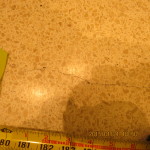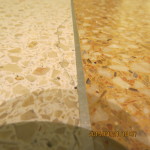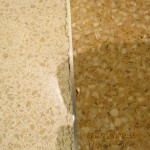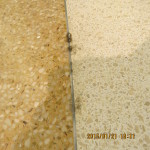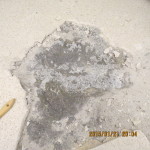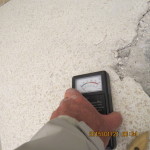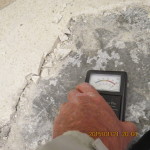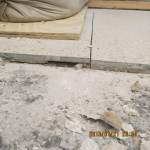No products in the cart.
Case Study
Investigation of Cracked Terrazzo Flooring

The Problem
Investigation of Cracked Terrazzo Flooring Background: CTaSC was retained to investigation why a terrazzo floor in a mall had developed cracks and staining. An epoxy terrazzo flooring assembly was installed in a mall about one year earlier. At some point the terrazzo flooring developed cracks, blisters, and tenting in various areas of the flooring. There were some repairs of various areas or conditions of the terrazzo floor, although in some cases the problem reoccurred. The terrazzo was installed over an existing concrete slab on-grade that had tile previously installed over it. Request: CTaSC was asked to investigate and inspect the terrazzo floor to determine the cause of the cracking, to determine the extent of the problems, to determine if the installation met industry standards, and to determine how best to remediate the problems.The Solution
Visual Inspection Findings:- When CTaSC performed a visual inspection no blisters were noticed and there was some slight tenting.
- There were lineal cracks in the terrazzo and there many cracks near or at the terrazzo divider strip.
- The areas around the divider strips were hollow sounding.
- Black residue was found in a number of spots adjacent to terrazzo divider strips.
- The moisture reading from on top of the terrazzo was very low. There were no symptoms of a moisture problem.
- It is unclear what combination of terrazzo products were used and to what extent.
- After removing a section of the terrazzo floor we could see that there was some sort of epoxy coating over the concrete. On top of that was an epoxy sand base that was applied in an irregular manner. There was some sort of membrane on top of the base with the terrazzo aggregate matrix applied on top of it.
- The terrazzo removed over the linear cracks showed that there was control joint in the concrete that had been covered.
- The exposed concrete had efflorescence staining.
- The moisture reading over the concrete was very high.
- The hollow areas of the terrazzo divider strip had voids, which indicated that the divider strip was not fully bonded with epoxy.
- It appears that the concrete slab had been subjected to high levels of moisture, which was mitigated to some degree with an epoxy coating.
- The control joints in the concrete slab should not have been covered. Movements in the control joints telegraphed up through the terrazzo assembly. They should have either been continued up through the terrazzo assembly, or the control joints should have been stabilized with dowels and epoxy.
- The terrazzo divider strips should have been fully bonded and supported with the epoxy leaving no voids, so it couldn't move. The movement in the epoxy caused the terrazzo to crack in those areas.
- The black residual at the terrazzo divider strips was un-reactive resin hardener residue, which is caused by not properly mixing the epoxy mix.
- Looking at how the terrazzo was installed there was a lot of inconsistency in how they mixed and applied the materials that further contributed to the problems.
- Our recommendation was to remove and replace the terrazzo floor in the area where there were defects.
- Use a single source terrazzo system manufacturer for the replacement. Prepare substrates and apply primers as required by manufacturer.
- Remove the terrazzo down to the concrete slab and then properly prepare the slab by scarifying it and patching it as necessary to level it out.
- Apply an epoxy moisture control coating.
- Apply a flexible crack isolation membrane.
- Install the terrazzo epoxy aggregate matrix.
- Grind and grout, polish to the required finish, and seal.

